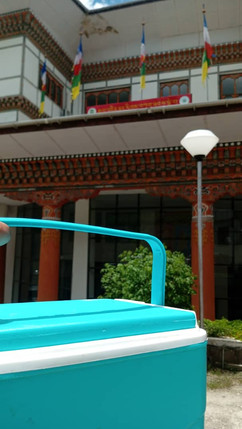Cross-sectional part in urban food environments concluded with a high success rate but with smaller numbers of participants compared to our earlier successes.
- Wim van Daele

- Sep 22
- 7 min read
The last cross-sectional part of the nutrition/microbiome phase in the EATWELL project took place between 5 July and 5 August 2025, among migrants from Laya, Gasa and Buli, Zhemgang in urban food environments. With this, our three cross-sectional parts are fully concluded. In contrast to the two successful cross-sectional studies in Laya and Buli, the number of participants in the last cross-sectional study was much smaller. We focused on migrants from Laya and Buli who have settled for at least one year in one of our identified urban food environments. Among the Laya migrants, we have been able to collect 25 samples, dietary recalls, and integrated surveys out of 51 identified eligible contacts, whereas among the migrants from Buli, we have collected 49 samples and data out of 83 identified eligible contacts. These numbers are smaller than what we hoped for but still constitute a high success rate. If the longitudinal research among the Laya participants continues to go well (see next blog), we may be able to compensate for the smaller number through comparative analyses with the seasonal migrants to these areas, so all efforts go now into ensuring that the longitudinal part ends successfully in March 2026!
After the successful completion of the cross-sectional study in Buli, Zhemgang, with 223 participants, we cross-checked the collected data to create a clean data file for analysis. We then also immediately started organizing the cross-sectional study in the urban food environments of the Paro, Thimphu, Punakha, and Wangdue districts (see map below). We have approached urban food environments as socio-ecological spaces marked by a food system where people are predominantly dependent on retail and markets to obtain their food, and this regularly includes an increased presence of industrially processed foods, often associated with the rise in Non-Communicable Diseases (NCDs), such as obesity, diabetes, high blood pressure, cancer and the like. ‘Urban’ food environments are mostly present in cities, but increasingly permeate rural villages as well, which is one of several good reasons to critically question the urban-rural divide and the very notions of the ‘urban’ and ‘rural’. Nevertheless, our selected ‘urban’ food environments are marked by a higher population density and a considerably higher prevalence of retail shops and restaurants or hotels, and where people are more dependent on a (global) food market with industrially processed foods, compared to our other sites in Laya and Buli marked by a higher degree of food production for domestic consumption.
Our aim has been to assess the influence of changing food environments on nutritional intake and the gut microbiome. For that, we have included 1st and 2nd generation migrants from Buli and Laya living in these urbanized food environments to determine the long-term evolution in nutrition and the gut microbiome over 2 generations. We have defined 1st generation migrants as people who have migrated within their lifetime and 2nd generation migrants as people born out of those who have migrated. Hence, we aim to assess this long-term evolution in nutritional intake and the gut microbiome through this cross-sectional study among migrants who migrated to and live in a different food environment and compare the data with the cross-sectional baselines in the areas of origin, that is Laya and Buli. This is a shortcut to study the influence of food system transformations and industrialization on people’s nutritional intake and gut microbiomes, which otherwise should be studied through very long-term longitudinal studies which are very costly and time-consuming, but which may perhaps be more accurate. Our initial hope to collect sufficient numbers for a powerful statistical analysis soon proved unrealistic. Yet, we tried to recruit as many participants as possible to conduct analyses with smaller statistical power as a kind of vignette analysis. Unfortunately, even that proved to be not fully possible, as we required a minimum of 50 participants in each group. Hence, the small numbers of our sample may complicate this kind of analysis, although we still can compare with the large numbers of samples and data collected from Laya and Buli and with the ‘urban’ data from the longitudinal part.
As we were already aware that recruitment might become a real challenge, we first asked our research assistants (RAs) to start snowball sampling while conducting the cross-sectional parts in Laya and Buli to identify potential participants in the urban food environments. Unfortunately, all our RAs failed to do so even though this was a clear task given to them. Yet, through my own networks, I was able to still collect a sufficient number to start snowballing from within the groups living in those urban environments, but this could only be started at the onset of the urban cross-sectional. As such, we had to combine further recruitment through snowball sampling and the actual cross-sectional study within the period of one month, which is not ideal.
Moreover, the uncertainty regarding the numbers of potential participants meant that it was impossible to prpoerly plan and organize the cross-sectional study across the four locations, which we identified and obtained the district approvals for. In addition, our attempts at planning became more complicated as two of our cross-sectional RAs had left the project early to go for higher studies in Australia. This meant that we had only four RAs left until 15 July after which another RA left early for his higher studies abroad. Happily, we got the help of our longitudinal RA in Buli, Tshering Tashi, so that we could still have four RAs after 15 July and until 5 august. Hence, the tight deadline, combined with the delayed snowball sampling and early attrition of RAs, squeezed the final cross-sectional part into a very narrow straight jacket, all contributing to the small numbers.
The uncertainty of how many participants the snowball sampling would yield and the tight timeframe in which all this had to happen, forced some difficult decisions onto us. In the ideal plan, we would have had all RAs go together to Punakha and Wangdue to sample and survey our participants, and then we would let them all go subsequently to Thimphu and finally to Paro. Yet given that snowball sampling had to take place simultaneously with these research activities and therefore would require extended presence in each site, we had to place two RAs in the urban area of Punakha and Wangdue, one in Paro and two in Thimphu until 15 July, after which I sent one RA from Punakha, where snowball sampling went difficult, to Thimphu where it was advancing much better.
This arrangement of working simultaneously across four different regions proved to be much more expensive by having to arrange continuous transport, lodging and fooding in each of the sites during the entire period and at the same time. Moreover, given the hot temperatures in Punakha and Wangdue, reaching 35 degrees, we had difficulties maintaining the temperature of the portable -80 freezer at an acceptable level, and additional electricity works were required to increase the power supply. This helped to keep it below -40 degrees, but this meant we had to organize additional transport of the samples to the Royal Centers for Disease Control in Thimphu on a weekly basis. And while samples were transported in the -80 freezer, the other samples collected had to be stored in a regular freezer until they could be transferred to the -80 freezer upon return from Thimphu, which thus meant we had to buy an additional regular freezer.
The work for the RAs consisted more practically of first contacting the potential participants to see if they would be interested in joining after they would briefly explain the project. Then they would make an appointment to explain the research in more detail and explain thoroughly the informed consent forms, and if they were willing to join, collect their consent and distribute the sample kits and explain how to use them. This thus required driving towards potential participants to meet them at their homes or elsewhere if more convenient, and again for collecting the samples and conducting the surveys.
Once the respondents had collected their stool sample, they were asked to contact the respective RA to come and collect the sample and conduct the 24-hours recall and the integrated survey. Given the summer heat in all four areas, the RA first had to collect the cooling elements from the freezer in the Thimphu EATWELL apartment and put these into one cooling bag and then put this bag into a chiller box. After collecting the sample, it first had to be scanned and then again be put into the cooling bag and chiller box together with the cooling elements. The sample was then brought back to the apartment and put into another regular freezer which we brought temporarily from Buli. Before closing time of RCDC, the samples were then transported there to transfer to their -80 freezers, and this every weekday. Hence, the whole process was logistically quite challenging for the RAs.
After one week into the month of the cross-sectional study, we saw that the sample and data collection was going slowly everywhere, even though the snowball sampling in Thimphu was going well. The RAs reported that it was easier to obtain informed consent than to collect the samples and conduct the survey, as many participants seemed to postpone it regularly for different reasons. On Sunday 20 July, we had a meeting to discuss the increasing gap between the snowball sampling and gathering of informed consent forms, on the one hand, and the collection of samples and conducting surveys, on the other. We decided to explain to participants that the continuous delays in their participation were causing the project financial losses and logistical inconvenience, but this did not seem to work.
By the end of July, we noticed that we still had this wide gap between people who had consented to participate versus those who had actually participated and that the latter numbers were still too low. Hence, I decided to extend the cross-sectional by one week (from 31 July to 5 august) in the hope that we could get at least a better number of participants, as more numbers generate better data, which is also an ethical obligation. I asked the RAs to stop snowball sampling as that had slowed down, and then to focus on those people who had consented. Yet, during the final week, several RAs reported several days that they had nothing to report.
So, all this led to large expenses and small numbers, but to end on a positive note, the number achieved for the Buli migrants is only 1 less than our aim of 50 people for the vignette analysis, so this will work, especially in comparison with the large number of 223 of the cross-sectional in Buli. Regarding the Laya migrants, we will be able to compare with around 35 Laya longitudinal participants who will spend their winter in these same urban food environments, and with the 227 samples collected in the cross-sectional in Laya. Given these smaller numbers, it will depend on the collected microbiomes and their degree of variation which levels and types of analysis will be possible and what kind of results we will find in the end…



































Comments